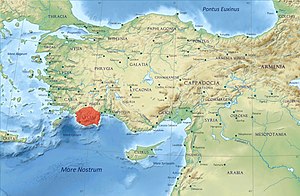Artumpara | |
|---|---|
 Portrait of Artumpara wearing the Achaemenid satrapal headdress, from his coinage. | |
| Allegiance | Achaemenid Empire |
| Years of service | fl. 400 – 370 BC |
| Rank | Dynast of Lycia |

Artumpara, also Arttum̃para, Artembares (Persian name, *Rtambura, self-identified as "the Mede) was an Achaemenid Satrap of Lycia circa 400-370 BCE.[1] He was involved in the Great Satraps' Revolt on the side of central Achaemenid authority in 366-360 BCE, helping to put down the rebel Datames.[2][3] He is well known for his coinage.[4]
Artumpara is known to have competed for power with another man named Mithrapata.[5] It is thought he was defeated by Perikle.[2]
Coinage[edit]
The portrait of Artumpara appears on his coinage, wearing the Achaemenid satrapal headdress.[2]
-
Coin of Artumpara, Satrap of Lycia, circa 400-370 BCE.
References[edit]
- ^ Brosius, Maria (2006). The Persians. Routledge. p. 28. ISBN 9781134359844.
- ^ a b c CNG: DYNASTS of LYCIA. Artumpara. Circa 400-370 BC. Stater (Silver, 7.62 g 9), Telmessos.
- ^ Briant, Pierre (2002). From Cyrus to Alexander: A History of the Persian Empire. Eisenbrauns. p. 673. ISBN 9781575061207.
- ^ André-Salvini, Béatrice (2005). Forgotten Empire: The World of Ancient Persia. University of California Press. p. 208. ISBN 9780520247314.
- ^ D. T. Potts, A Companion to the Archaeology of the Ancient Near East (2012), p. 912: "...c. 380–370 BC, two western Lycian dynasts named Arttumpara and Mithrapata claimed power simultaneously."


Well, that’s interesting to know that Psilotum nudum are known as whisk ferns. Psilotum nudum is the commoner species of the two. While the P. flaccidum is a rare species and is found in the tropical islands. Both the species are usually epiphytic in habit and grow upon tree ferns. These species may also be terrestrial and grow in humus or in the crevices of the rocks.
View the detailed Guide of Psilotum nudum: Detailed Study Of Psilotum Nudum (Whisk Fern), Classification, Anatomy, Reproduction